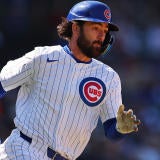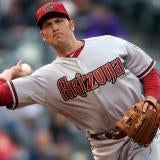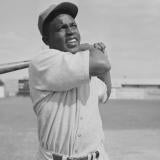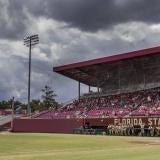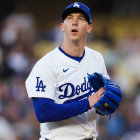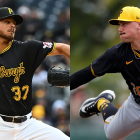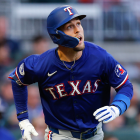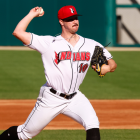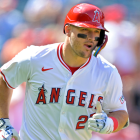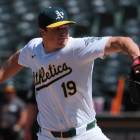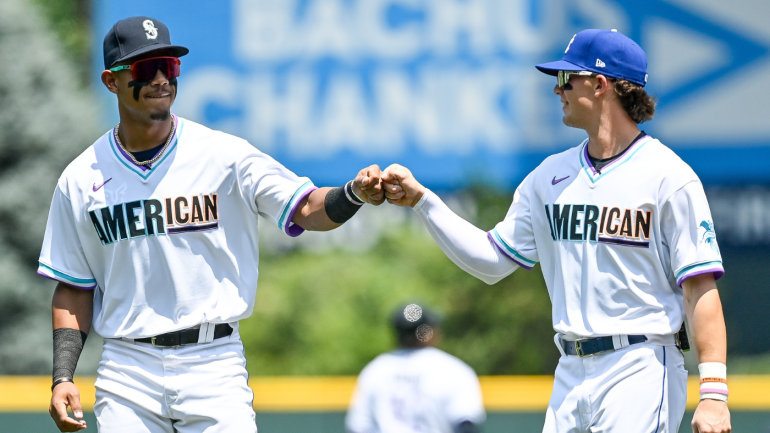
In December, Major League Baseball's owners voted to lock out the players, triggering the league's first work stoppage since 1994-95. From now until whenever the lockout is lifted (after the ratification of a new Collective Bargaining Agreement by both the league and the MLB Players Association), there won't be free-agent signings, trades, or any of the usual hot-stove madness that tends to populate the winter months.
Nevertheless, CBS Sports has spent the last couple weeks breaking down the top prospects in baseball, both globally and on a team-by-team basis. That process continues today, with a recap of every team's top prospect.
Do note that the players below were identified as the top talents in the minors following conversations with scouts, analysts, and player-development types. As always, this is more of an art than a science, and some disagreement is a given. Let's get to the list.
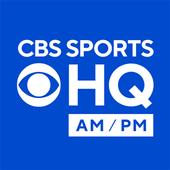
CBS Sports HQ Newsletter
Your Ultimate Guide to Every Day in Sports
We bring sports news that matters to your inbox, to help you stay informed and get a winning edge.
Thanks for signing up!
Keep an eye on your inbox.
Sorry!
There was an error processing your subscription.
| Alek Thomas, OF: The Diamondbacks organization has made a habit out of taking undersized outfielders. Thomas, listed at 5-foot-11, is one of the prizes from that approach. Thomas authored a breakout season this year, batting .313/.394/.559 with 18 home runs, 29 doubles, and 12 triples in 106 contests across Double- and Triple-A. Thomas has a noisy swing, including an elongated leg kick, that helps him generate more power than his size indicates (encouragingly, the moving parts have not resulted in a high strikeout rate). Add in his good defense, and he should become the Diamondbacks' starting center fielder as early as this spring. | |
| Michael Harris, OF: Harris is a fascinating prospect. He was a two-way player in high school who has since toyed with switch-hitting just because. He's made a quick ascent up the Braves' list since being drafted in the third round in 2019 thanks to a tool set that could feature five above-average or better grades at maturation. Harris spent last season in High-A, where he batted .294/.362/.436 with seven home runs and 27 stolen bases (on 31 tries). Some scouts aren't sure if Harris will be able to remain in center for the long haul, but his bat should more than play in a corner. And if he does stick? He could be a star. | |
| Adley Rutschman, C: Rutschman, the No. 1 pick in the 2019 draft, is on the precipice of stardom. Evaluators have maintained that he would someday feature four plus or better tools (everything but the speed), as well as an excellent feel for the strike zone and field-general qualities. Rutschman, a switch-hitter, has lived up to expectations. He batted .312/.405/.490 in 43 games at Triple-A, suggesting the only thing standing between him and the majors is the Orioles' desire to suppress his wages. Even they won't be able to hold down Rutschman for long; he's the future of the catcher position. | |
| Marcelo Mayer, SS: Mayer entered last summer's draft ranked by CBS Sports as the No. 1 prospect on the board. He ended up going fourth overall to the Red Sox, who, in our estimation, should thank their lucky stars. Mayer's boosters believe he'll be a well-rounded left-handed hitter who can contribute average, on-base, and slugging once he adds enough strength to his frame to launch 15-to-20 home runs annually. While he's not a fast runner, he is a skillful defender who has the arm, the hands, and the fluidity to remain at shortstop. Mayer's exact ceiling hinges on his aforementioned physical maturation, but if he gets close to his peak he'll become a two-way contributor and an All-Star. | |
| Brennen Davis, OF: Davis possesses the best chance of developing into a star of anyone on the Cubs farm. He has a dynamic collection of tools, including plus or better grades with his power and speed, and he has an established track record of performance. This past season, he batted .260/.375/.494 with 19 home runs across three levels, including a 15-game stint at Triple-A that saw him post a .933 OPS. Davis should make his big-league debut in 2022; he's likely to at least begin his career as a center fielder, though he might have to move off the position if and as he adds muscle to his frame. | |
| Colson Montgomery, SS: The White Sox took Montgomery with the 22nd pick in July's draft. He subsequently hit .287/.396/.362 as part of a 26-game stint in rookie ball. Montgomery engendered Corey Seager comparisons during his amateur days because of his tall frame (he's listed 6-foot-4) and a left-handed stroke that should provide plenty of power at his peak. Obviously those comparisons should be taken with a grain of salt since they make a good outcome (Montgomery becoming a fine starting-caliber shortstop) into a potential disappointment, but they're fun to think about now and again, aren't they? | |
| Nick Lodolo, LHP: Lodolo was the first pitcher to come off the board during that 2019 draft, albeit relatively late at No. 7. He's atoned for it by zipping through the minors, accruing a 2.31 ERA and a 7.09 strikeout-to-walk ratio in 13 starts across Double- and Triple-A in his first full professional season. (He was hampered by blisters and shoulder fatigue.) Lodolo doesn't have loud stuff; he does have a good slider and a broad arsenal of averageish offerings that play up because of his command and the deception he creates with a lower release point. Provided Lodolo is hearty and hale, he ought to debut early this spring, with a straightforward path toward mid-rotation status. | |
| Daniel Espino, RHP: History is not on the side of first-round high-school righties, yet Espino continues to reward the Guardians for selecting him 24th overall a few summers ago. In his first full professional season, he posted a bananas strikeout rate of 14.9 per nine innings across 91 frames. Arguably the wildest part of that number is that both his strikeout and walk rates improved after a midseason promotion to High-A, with the former jumping to 16.2 per nine and the latter dipping to 2.9 per nine. Espino is able to miss bats with a fastball he can dial into the upper-90s and a pair of average or better breaking balls. He needs to continue to work on his changeup and command -- he is a 21-year-old, after all -- but there's enough upside here to give him this ranking. | |
| Zac Veen, OF: The Rockies selected Veen, an angular left-handed hitter who often received Jayson Werth comparisons from scouts as an amateur, ninth in the 2020 draft. He made his professional debut last season, hitting .301/.399/.501 with 15 home runs and 31 troubles (doubles plus triples) in 106 games at Low-A. Veen has all the right weaponry to become a middle-of-the-order hitter: good power; a feel for the zone; and barrel awareness. He also has a strong arm that should come in handy in right field | |
| Riley Greene, OF: Greene, the fifth pick in the 2019 draft, split his first full professional season between Double- and Triple-A, hitting .301/.387/.534 with 24 home runs, 33 troubles (triples plus doubles), and 16 stolen bases on 17 tries. He celebrated his 21st birthday in September. Predictably, Greene is considered to be an intelligent, polished hitter who should fit in near the top of Detroit's lineup at some point early in the season. The big question is where he'll play defensively. The Tigers have primarily played him in center so far, and it's possible that's where he begins his big-league career before eventually sliding to a corner (he has enough of an arm for right if so desired). | |
| Jeremy Peña, SS: Peña may have made his big-league debut last season had he not undergone wrist surgery in the spring that wiped out most of his year. He did return for a 30-game stretch in Triple-A to close out the campaign, where he hit .287/.346/.598 with 10 home runs. (He's since hit .291/.364/.410 in 30 winter ball games, suggesting his wrist has healed up fine.) At his peak, Peña figures to offer a well-rounded skill set: he'll hit for average, some power, and provide value as both a defender and a baserunner. The one aspect worth monitoring with Peña's game as he nears The Show is his approach: between the minors and winter ball, he's posted a 3.94 strikeout-to-walk ratio; good for a pitcher, not so much for a hitter. | |
| Bobby Witt Jr., SS: Witt proved why he was picked second in the 2019 MLB Draft last year by hitting .290/.361/.575 with 33 home runs and 35 doubles across Double- and Triple-A in his first full professional season. There used to be fear that Witt would swing-and-miss too frequently to maximize his loud offensive tools; those concerns haven't materialized, and he struck out in just 22.5 percent of his Triple-A plate appearances. Factor in an above-average glove, and Witt should accomplish something his father never did over the course of his 16-year big-league career as a pitcher: make an All-Star Game. | |
| Reid Detmers, LHP: The book on Detmers coming out of Louisville was that he was a polished strikethrower who would move through the minors quickly. Sure enough, Detmers reached the majors after 13 professional appearances. He ended up making five big-league starts, during which he amassed a 7.40 ERA and a 1.73 strikeout-to-walk ratio. Those numbers belie that he's still a legitimate mid-rotation prospect who pairs a low-90s fastball with a big-time curveball and a slider that fared well in The Show. Detmers should get a longer look in the majors in 2022, and those numbers should improve as the sample size increases. | |
| Bobby Miller, RHP: Coming out of Louisville, there were enough scouts who felt Miller would wind up in the bullpen that he slipped to the Dodgers at the end of the first round. Naturally, fewer than two years later, he seems more certain to stick in a rotation. Miller's best pitches are his mid-90s sinker and his slider, and he's seen both his changeup and command tick up since turning pro. If there's one blemish to his game at this point, it's a lack of exposure. The Dodgers micromanaged his outings last season, to the point where he averaged fewer than four frames per appearance. The game is changing, with starters shouldering fewer and fewer innings, but that's still on the light side for a perceived starter. Even so, Miller ought to reach the majors in 2022. | |
| Kahlil Watson, SS: Watson, who slid to the middle of the first round, could prove to be one of the biggest steals of the draft. He has a beautiful left-handed swing that he delivers with an explosiveness that bodes well for his quality of contact. His boosters across the industry believe he'll develop into a well-rounded hitter as he gains experience against more advanced pitching. Opinions are more split on his long-term defensive home, with some evaluators envisioning him ending up in the outfield, where his above-average speed and arm strength could make him a dynamic asset. | |
| Aaron Ashby, LHP: We highlighted Ashby last fall as a rookie who could put himself on the map with a strong postseason. He didn't; instead, he gave up five hits and two runs in 2 2/3 innings of relief. Oh well. Ashby figures to get a chance to start again next season, and he would seem to have a decent shot at making it work. He has a legitimate out pitch, in his slider, as well as a mid-to-upper-90s sinker and two other secondary pitches to keep batters honest. Ashby has already proved he can miss bats and turn over a lineup once; it's not out of the question that he becomes a mid-rotation type, and soon. The worst-case scenario has him returning to the bullpen as a multi-inning buzzsaw. | |
| Austin Martin, UTL: The Twins acquired Martin, the fifth pick in the 2020 draft, as part of a deadline trade that sent José Berríos to Toronto. Martin spent his first pro season in Double-A, hitting .270/.414/.382 with five home runs and 14 steals (on 18 tries). There's no doubting his feel for contact or his command of the strike zone; nevertheless, there remain questions about his power potential and his defensive home. If Martin is slugging at below-average levels, and if he has to move down the defensive spectrum, then that complicates his overall profile. Let's see how Martin fares with a full offseason of instruction from the Twins before rushing to any conclusions. | |
| Francisco Álvarez, C: Álvarez only turned 20 years old in November. Despite his youth, he hit .272/.388/.554 with 24 home runs across two levels in 2021. Part of Álvarez's season included a stint with the St. Lucie Mets. It was then that he posted the highest average exit velocity the league saw all season -- and that league included the likes of Jordan Walker, Anthony Volpe, and Austin Hendrick. It's rare to see such offensive potency from a young backstop who is certain to remain behind the plate. Álvarez figures to open the year in Double-A; he's one to watch. | |
| Anthony Volpe, SS: Volpe, the 30th pick in the 2019 draft, suffered through a rough introduction to professional ball. You wouldn't know it based on how well he played last season. After adding strength to his frame, he batted .294/.324/.604 with 27 home runs and a rules-inflated 33 stolen bases. His strikeout rate did jump after his promotion to High-A, and that merits keeping an eye on heading forward. At present, though, he projects to become an above-average hitter in terms of contact and power. Volpe's long-term defensive home is up in the air because of his substandard arm strength, but the Yankees have played him almost exclusively at shortstop to date, suggesting they still have faith in him there. | |
| Tyler Soderstrom, C/1B: Soderstrom was considered one of the top prep catchers in the 2020 class, but even then scouts expressed a desire to move him elsewhere. Those wishes weren't cast because of a disdain for his defense so much as a belief in his bat. Soderstrom, evaluators feel, has a chance to become a middle-of-the-order hitter thanks to his feel for hard contact and the strike zone alike. He showed as much by bullying his A-ball competition in his first full professional season, hitting .306/.390/.568 with 12 home runs and 21 troubles (triples plus doubles) in 57 games. The A's still permitted Soderstrom to catch most of the time, but they did give him a look at first base, suggesting even they're considering their options to maximize his stick. | |
| Mick Abel, RHP: Abel, the top prep pitcher in the 2020 class, slipped to the 15th pick because of the usual concerns about high-school arms. While it's too early to panic, his first professional season brought those concerns to the forefront. Abel was limited to 14 starts by a shoulder issue, and he walked more than five batters per nine when he was able to pitch. Abel still has well-above-average upside, thanks to an arsenal that could include three plus or better pitches and a tall, projectable frame. | |
| Oneil Cruz, SS: Cruz's availability at this point last year was up in the air after he was involved in a car accident that killed three people. (Cruz's lawyer and the Pirates pushed back against reports suggesting alcohol was involved.) He ended up playing in 68 minor-league games and then, surprisingly, two big-league contests to end the season despite limited Triple-A exposure. Cruz has one of the oddest profiles in the game stemming from the fact that he's a 6-foot-7 shortstop. The Pirates haven't hedged their bets against him sticking there by so much as cross-training him at other positions. They're all-in, in other words. Cruz has big-time power and he's a fast runner (at least for the time being), making him a potentially dynamic offensive talent. He also cut into his strikeout rate this season, too, which bodes well for him given his hit tool has been scrutinized in the past. Cruz should get a longer look in the majors this year. | |
| Jordan Walker, 3B: Walker made his professional debut last season, hitting .317/.388/.548 with 14 home runs and 29 troubles (that's doubles plus triples). Walker has near-elite raw power and, in a promising development as it pertains to maximizing its utility, he started lifting the ball more frequently after being promoted to High-A. His strikeout rate also spiked following his move up the ladder, moving up from 17 to 27 percent, but it's easy to give him a pass on that for now because he won't celebrate his 20th birthday until May. Walker may in time have to move away from the hot corner, likely to another corner; it won't matter if he turns into a marquee slugger. | |
| CJ Abrams, SS: Abrams, yet another member of that vaunted 2019 draft class (he was selected sixth overall), may have made his big-league debut late last season had he not broken his leg and sprained his MCL as part of a June collision. Prior to that incident, he had hit .296/.363/.420 with 16 extra-base hits and 13 stolen bases (on 15 tries) in 42 contests at the Double-A level. It's to be seen if Abrams' elite speed will be impacted by his injuries. Provided the answer is "no," he could slot into the Padres' lineup early next year as a hit-over-power option at either of the middle-infield positions. | |
| Marco Luciano, SS: As with Marte, Luciano is a young 20-year-old who projects as a middle-of-the-order hitter with positional question marks. (Marte gets the higher spot because he seems more likely than Luciano to remain at shortstop.) Luciano did scuffle after reaching High-A for the stretch run -- he hit just .217/.283/.295 with a 37 percent strikeout rate -- but it's not worth panicking or pressing the eject button just yet. The sample size is too small and his upside, particularly with the stick, is too big. He should get the opportunity to vindicate himself to begin thí 2022 season. | |
| Julio Rodriguez, OF: Rodríguez fits the right-field prototype with a middle-of-the-order offensive projection and a strong arm. He has well-above-average power and a better feel for contact than most with this profile. Indeed, Rodríguez struck out in just 18 percent of his plate appearances during his 46-game introduction to Double-A last season, an impressive piece of business for someone who can't legally drink until Dec. 29. The Mariners have shown they're more than willing to manipulate the service time of their top prospects to save a buck, suggesting they'll likely do the same thing with Rodríguez. Nonetheless, he should debut in the majors before the season is out. | |
| Shane Baz, RHP: Baz is the lone member of the top 20 who has already reached the majors. He appeared in three regular season contests with the Rays in 2021, accruing a 2.03 ERA and a 6.00 strikeout-to-walk ratio in a small sample of 13 innings. Baz demonstrated during his big-league cameo that he has three swing-and-miss pitches, including an upper-90s fastball (with movement and release-point characteristics that rival Gerrit Cole's) and a pair of breaking balls. He's simplified his delivery since being acquired from the Pirates as part of the ill-fated Chris Archer trade, allowing him to tally just 16 walks in 92 combined innings between the majors and minors last season. That would be impressive for anyone, let alone someone who was issuing a walk every other inning prior to the pandemic. Between Baz's pure stuff and his newfound control, he's the favorite to eventually succeed Tyler Glasnow (who also came over in that trade) as the Rays ace. | |
| Jack Leiter, RHP: Leiter was the first pitcher to come off the board in July's draft, and for good reason. In addition to having big-league bloodlines and an SEC certification, he possesses many of the traits teams seek in their pitchers these days, including an electric fastball and a release point that creates tough angles up in the zone. Leiter needs to find greater consistency with his secondaries and his command, but talent evaluators believe he's capable of making those gains in short order; to wit, a veteran scout told CBS Sports that Leiter's pre-draft interview was one of the best he's experienced. | |
| Gabriel Moreno, C: Moreno won't turn 22 years old until February, and he's caught fewer than 200 professional games so far because of the pandemic and a fractured thumb. Even so, his upside and progress on both sides of the ball make him a highly promising backstop prospect. Moreno hit .367/.434/.626 eight home runs in 37 games across three levels last season; he then appeared in 22 games in the Arizona Fall League, where he batted .329/.410/.494 with a walk for every strikeout. In addition to adding strength at the plate, Moreno has improved his receiving capabilities behind it. The eventual implementation of the automated ball-strike system might render some of his work moot, but it speaks well of his eagerness to get better -- and his chances for stardom. | |
| Keibert Ruiz, C: The Nationals acquired the switch-hitting Ruiz from the Dodgers as part of the payout on Max Scherzer. Ruiz had, throughout his development, been known for an extreme contact-over-power offensive profile; that seemed to change in 2021, as he lifted the ball more in the minors en route to a career-high 21 home runs. Ruiz's tweaks didn't translate to the majors (in a small sample), but his power playing closer to average would represent a game-changing development for him given his bat-to-ball skills. Ruiz is adequate behind the dish, which makes him a starting-caliber catcher regardless; if the power sticks, he could become a first-division starter. | |





































